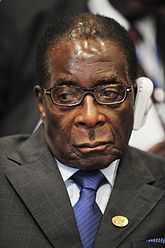Sally Hayfron
| Sally Hayfron Mugabe | |
|---|---|
 after a state visit to the United States in 1983 | |
| Born |
Sarah Francesca Hayfron 6 June 1931 Gold Coast (now Ghana) |
| Died |
27 January 1992 (aged 60) Harare, Zimbabwe |
Cause of death | Kidney failure |
| Other names | Sally Mugabe |
| Occupation | Teacher |
| Title | First Lady of Zimbabwe |
| Successor | Grace Marufu |
Political party | ZANU PF |
| Religion | Roman Catholic |
| Spouse(s) | Robert Mugabe |
| Children | Nhamodzenyika (1963–1966) |
| Relatives |
Mavis Hayfron (mother), John Hayfron (father), Esther Sophia Hayfron (twin sister), Jane Hayfron (sister), Isabella Hayfron (sister) |
Sarah Francesca (Hayfron) Mugabe[1] (6 June 1931 – 27 January 1992), a.k.a. Sally Mugabe, was the first wife of Robert Mugabe, the President of Zimbabwe and the First Lady of Zimbabwe from 1987 until her death in 1992. She was popularly known as Amai (Mother) in Zimbabwe.[2] The death of Sally is seen by some to be around the time that President Robert Mugabe began indurating his policy in Zimbabwe.
Early life
Born in 1931 in the Gold Coast (present-day Ghana), then a British colony, Sally and her twin sister, Esther, were raised in a political family, which was part of the growing nationalist politics in the colonial Gold Coast. She went to Achimota Secondary School, she went on to university to study before qualifying as a teacher.
Sally Hayfron was a trained teacher who asserted her position as an independent political activist and campaigner. She demonstrated this activism as early as 1962 when she was active in mobilising African women to challenge the Rhodesian constitution which resulted in her being charged with sedition and sentenced to five years imprisonment, part of which was suspended.
She met her future husband, Robert Mugabe, at Takoradi Teacher Training College where they were both teaching.
Exile and family
Hayfron married Robert Mugabe in April 1961 in Salisbury.[3] In 1967, Sally went into exile in London, and resided in Ealing Broadway, West London; her stay in Britain was financed, at least in part, by the British Ariel Foundation.[4] She spent the next eight years agitating and campaigning for the release of political detainees in Rhodesia, including her husband who had been arrested in 1964 and was to remain incarcerated for ten years. Their only son, Nhamodzenyika, who was born in 1963 during this period of detention and imprisonment, would succumb to a severe attack of malaria and die in Ghana in 1966. Her father also died in 1970. The British Home Office attempted to deport her, but after her husband petitioned the British Prime Minister, Harold Wilson, and the Foreign and Commonwealth Office,[5] she was given British residency.[2][4] Her case for residency was supported by two British Government ministers in particular: Maurice Foley, M.P., from the Labour Party, and Lord Lothian, from the Tory Party. Mugabe was prevented from attending the burial of his son.
With Mugabe's release in 1975 and subsequent departure for Mozambique with Edgar Tekere, Sally rejoined her husband in Maputo. Here, she cast herself in the new role of a mother figure to the thousands of refugees created by the Rhodesian Bush War. This earned her the popular title Amai (Mother).
Return to politics
In 1978 she was elected ZANU-PF Deputy Secretary for the Women's League. In 1980 she had to make a quick adjustment to a new and national role of the wife of Zimbabwe's first black Prime Minister. She officially became the First Lady of Zimbabwe in 1987 when her husband became the second President of Zimbabwe. She was elected Secretary General of the ZANU-PF Women's League at the Party's Congress of 1989.
She also founded the Zimbabwe Child Survival Movement. Sally Mugabe launched the Zimbabwe Women's Cooperative in the UK in 1986 and supported Akina Mama wa Afrika, a London-based African women's organisation focusing on development and women's issues in Africa and the United Kingdom.
Death and remembrance
Sally died on 27 January 1992 from kidney failure. Upon her death she was interred at the National Heroes Acre in Harare, Zimbabwe. In 2002, to mark the 10th anniversary of her death, Zimbabwe issued a set of four postage stamps, of a common design, using two different photographs, each photograph appearing on two of the denominations. She is remembered fondly with love and affection, as she is still considered the founding mother of the nation of Zimbabwe.[2]
References
- ↑ UK National Archive reference to Sally as "Sarah Francesca Mugabe"
- ↑ 2.0 2.1 2.2 Verkaik, Robert (6 April 2008). "The love that made Robert Mugabe a monster". The Independent (London). Retrieved 17 April 2008.
- ↑ Nyarota, Geoffrey. Against the Grain. Page 101-102
- ↑ 4.0 4.1 Source of finance and partial text of a letter to Harold Wilson given here (see also footnote 57 of that source)
- ↑ Text of letters, telegrams etc. between Mugabe and various British Ministers and officials and the Ariel Foundation
External links
| |||||||||||||||||||||||||||||
